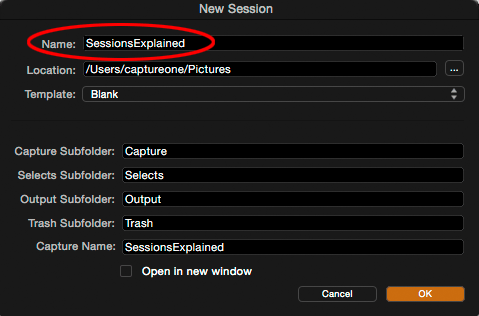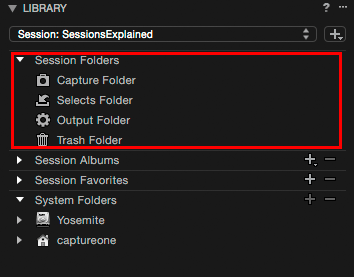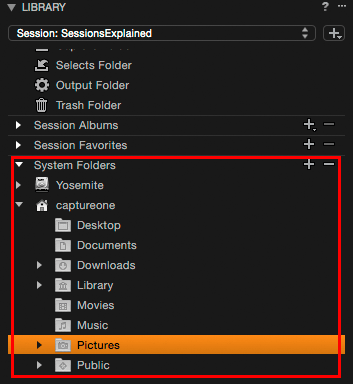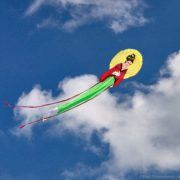Sessions Explained
When you start with Capture One Pro, you get the question to either use (or create) a Session or a Catalog. This is a choice between library types and using either one is mandatory. This tutorial blog will explain what a Session is and when you might prefer it over a Catalog. Please note I have a similar blog on the Catalog.

Sessions Explained
Capture One has been working with sessions from day one. It stems from the time that digital backs needed a computer connected to view and store their images. Tethering was the only way to go. No memory card or LCD display where available back then. Before we jump into more detail, please note that you can browse and open your disk folder as well with a Capture One Session. Read more on that under System Folders below.
Shoot To A Session
Imagine you have a shoot and you set up some folders on your disk beforehand. One folder named after the shoot (subject, customer, date) as parent folder, and a few subfolders for the incoming captures, the selected images, the trashed and the processed images.
To summarise, one main folder with four subfolders. The main folder has a unique and sensible name. The subfolders have a name that expresses their function. Got that? Then you just made a session in your head. Congrats! How do you feel?
Capture One Does It For You
With Capture One Pro you create a Session by providing a unique and sensible name and click OK. You give the main folder a unique name. Capture One Pro automatically creates the subsequent subfolders in a blink of an eye. Start shooting, or import your images from a card if you like.
These four subfolders have the same name in each session: Capture, Selects, Output, Trash. The Capture One Library tool lists them as Session Folders.
From Folder to Function
You now understand the basics of a Session: one unique main folder with four subfolders. These four subfolders always have the same names, since they are their related functions within Capture One.
Capture One places incoming images in the Capture folder, you move selected images into the Selects folder, processed images go into the Output folder, and trashed images into the Trash folder.
Four functions, four folders. Please note that the System Trash is not used. Also note that as each Session has its own set of Session Folders, each has its own Trash folder.
System Folders
You wanna break free! Have it your own way! No problem. Especially for the I-never-use-sessions kind of guy, a Session is a way to go. Contradiction? Keep on reading.
Open or create a Session. Next, in the Library tool browse your folders under the System Folders heading. Done.
Is It Right For Me?
Working with Session is the right way to go if you like to browse your System Folders. Period. You can not do that from a Catalog. Sessions are also great when you do not need Capture One to organize your collection of images. You perhaps do not need it at all or have other software for that purpose.
Be aware, however, that a Session works best from your local hard drive or SSD because even a very brief disconnect may corrupt your Session. Also for performance reasons a local drive is preferred.
Since the previews and settings from Capture One are stored in a subfolder of the image folder, Capture One needs indisputable disk access. This settings-in-subfolder thing can be a reason to prefer the Catalog.
Want More?
Maybe this blog got you covered. Great. Maybe you noticed that we skipped some interesting topics like Session Albums and Favorites, among others. These topics and more will be explained in a succeeding blog named Sessions Continued.
Thank You
For reading. Please feel free to leave a comment. Like us on Facebook or subscribe to our newsletter to stay informed about new blogs.
Best Regards,
Image Alchemist














Thanks for clear explanation! Will follow your site…
Hi..
Thanks for explaining what a session is. It was really helpful. I have a doubt, please help. In capture one 8 (trial), i created a session. If i right click on capture folder, it has an option.. New inside “capture folder”.. why cant i access that option.
Hi Namita, I assume you are on Windows. I think this is a bug. The option should allow you to create a new folder. A workaround is: right-click on Capture Folder, select ‘Show in System Folders’. From the System Folders (below in Library) you can right-click on the same folder and create a new sub folfder.
Is there any advantage to setting the preview images to write to a separate disk than where the images are stored? Say if I had a PCIE SSD with my OS on it, and a sata SSD for mass data storage.
Hi Hollis,
As far as session are concerned, there is no option to store previews in another location then in a subfolder to your image folder.
Best, Paul Steunebrink / Image Alchemist
Hi Paul,
Thanks for explaining the Sessions. I’m running into a problem and hope you’re able to help me with this, let me explain. By default C1 stores the Capture folder contents on C:\user\pictures. Not only the RAW files will be stored there but also the cof files containing all the adjustments. When moving these files to another location, preferably to the actual capture folder so I’ve got all my data in one main folder, the link gets broken and I’ve lost all my adjustments.
Q: is there any way I can move the capture folder to a new location while I’m still able to regain my adjustments? (this is about already created sessions. I’m aware that I’m able to correct this during the creation of a new session).
Thanks in advance for your support.
Regards, Jaap.
Hi Jaap,
Move you images to a different location from within Capture One (Library tool). This will ensure that your adjustments will stick to the images.
Best, Paul Steunebrink / Image Alchemist
Hi Paul,
What do I do when I have created a session template and want to use this on different machines? Do I have to do the same process precisely the same way on each machine or can I just copy and paste in some way?
Hi Nils, you can copy the templates from one computer to another. You find them in the Application Support folder. How to locate that folder is described in this blog Installing Presets and Styles
Best, Paul Steunebrink / Image Alchemist
Hi Paul,
I’m learning C1 and have created a Session that appears to have imported another copy of my source files and named them as filename-1, filename-2, etc. I think I imported them twice? Somehow. I’d like to delete this session and start over. How do I delete a Session? I’m using C1 ver 12.
I’d really like to understand this. It seems that the import will create a copy of the source files and put them in the Capture folder? I’m shooting with the GFX100 and the files are large and are filling my SSD already. Should I just put the source files in the Capture folder manually? Or just designate the source folder and not perform an import? I’ve backed them up to an external HDD. I’d like to recover some space for the SSD.
Thanks for the blog. I appreciate any advice you have.
PaulJ
Hi PaulJ,
With a Session, import always means copy. In case that your files are already on your SSD, just browse to them from the System Folders section in the Library tool.
You can delete a Session from the Finder. Alternatively, you can leave the Session as is, clean the Capture folder, and browse to your images as mentioned above.
Best, Paul Steunebrink / Image Alchemist